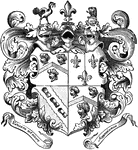
Cricket
Crickets, family Gryllidae (also known as "true crickets"), are insects somewhat related to grasshoppers…
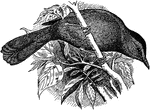
Gray Catbird
The Grey Catbird (Dumetella carolinensis) is a medium-sized northern American perching bird of the mimid…

Yellow-throat Vireo
The Yellow-throated Vireo, Vireo flavifrons, is a small American songbird. Adults are mainly olive on…

Ovenbird
The Ovenbird, Seiurus aurocapillus, is a small songbird of the New World warbler family. Ovenbirds are…

Pine Warbler
The Pine Warbler, Dendroica pinus, is a small songbird of the New World warbler family. These birds…
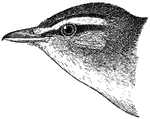
Red-eyed Vireo
The Red-eyed Vireo, Vireo olivaceus, is a small American songbird, 13-14 cm in length. It is somewhat…

Warbling Vireo
The Warbling Vireo, Vireo gilvus, is a small songbird. Adults are 12 cm long and weigh 12 g. They are…
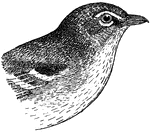
Yellow-throated Vireo
The Yellow-throated Vireo, Vireo flavifrons, is a small American songbird. Adults are mainly olive on…
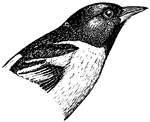
Baltimore Oriole
The Baltimore Oriole, Icterus galbula, is a small icterid blackbird which is on average 18 cm long and…
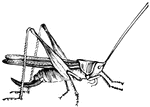
Cricket
Crickets, family Gryllidae (also known as "true crickets"), are insects somewhat related to grasshoppers…
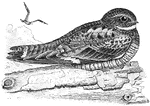
Nighthawk
Nighthawks are birds of the nightjar family in the New World subfamily Chordeilinae. They are medium-sized…
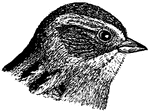
Swamp Sparrow
The Swamp Sparrow, Melospiza georgiana, is a medium-sized sparrow. Adults have streaked rusty and black…

Centipede
Centipedes are arthropods belonging to the class Chilopoda and the Subphylum Myriapoda. They are elongated…
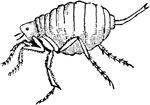
Chigoe Flea (Male)
The chigoe flea (Tunga penetrans) is a parasitic arthropod found in tropical climates, especially South…
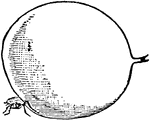
Chigoe Flea (Female)
The chigoe flea (Tunga penetrans) is a parasitic arthropod found in tropical climates, especially South…
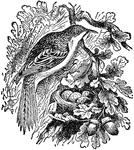
Brown Creeper
The Brown Creeper (Mohoua novaeseelandiae), also known by its Māori name, Pipipi, is a small…

Combined Arms of the Washington Family
The coat of arms of George Washington, President of the United States of America from 1789 to 1797,…

Washington's Seal (From a Letter to Bouquet, 1758)
Washington's Seal incorporates the same design which can be found in Washington's Arms. The coat of…

Washington's Private Seal, 1783
Washington's Private Seal incorporates the same design which can be found in Washington's Arms. The…

Washington Arms
The coat of arms of George Washington, President of the United States of America from 1789 to 1797,…
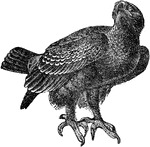
Screamer
The Screamers are a small family of birds, the Anhimidae.The three species occur only in South America,…

Black Rock Scorpion
The Black Rock Scorpion (Scorpio (Buthus) Afer), "seen from above. At, the chelicerae, or chelate antennae;…

House Centipede
The House Centipede (Scutigera coleoptrata) is a yellow and gray centipede with thirty legs. It was…

Lynx
A lynx is any of four medium-sized wild cats. All are members of the genus Lynx, but there is considerable…

Ground Squirrel
The ground squirrels are the members of the Sciuridae most closely related to the genus Marmota. They…
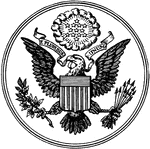
Great Seal of the United States
The Great Seal of the United States with "E. Pluribus Unum" and a bald eagle holding thirteen arrows…

Seal of Delaware
The Seal of the State of Delaware, 1793-1847. The seal shows a farmer, a soldier, Delaware's coat of…

Seal of Michigan
The Great Seal of the State of Michigan. This seal shows the Michigan's coat of arms held by an elk…

Seal of Wisconsin
The Great Seal of the State of Wisconsin. The seal shows a sailor and a yeoman holding the state's coat…
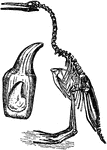
Hesperornis
Hesperornis is an extinct genus of flightless aquatic birds that lived during the Santonian to Campanian…
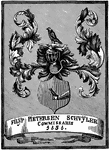
Schuyler Arms
The Schuylers were foremost among early Albany's founders and leaders and became one of the most prominent…
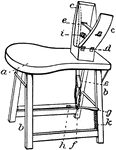
Sewing Horse
"Sewing-horse. In saddlery, a sewing-clamp with its supports. a, seat; b, legs; c, c', clamping-jaws,…
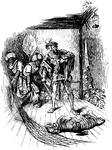
Tiger Attack
A scene from "A Little Field of Glory." A soldier rescues the main character, Thomas, from an attack…
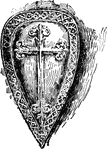
Medieval Shield
A shield of mounted men-at-arms from the first half of the 13th century, considered the High Middle…

Quarterly Shield
"Quarterly, first and fourth argent, a chevron gules, second and third gules, a cross argent (that is,…

Simple Crinoid
An illustration of a simple five armed crinoid with a detailed view of the tegmen of five orals. Crinoids,…
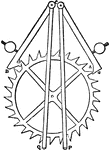
Mudge's Gravity Escapement
A gravity escapement uses a small weight or a weak spring to give an impulse directly to the pendulum.…

Bloxam's Gravity Escapement
A gravity escapement uses a small weight or a weak spring to give an impulse directly to the pendulum.…

Legs of the Hive Bee
Honey bees (or honeybees) are a subset of bees, primarily distinguished by the production and storage…

Legs of the Stingless Bee
Stingless bees, or simply meliponines, are a large group of bees, comprising the tribe Meliponini in…
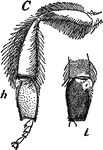
Legs of the Humble Bee
A bumblebee (or bumble bee) is any member of the bee genus Bombus, in the family Apidae. Pictured here…
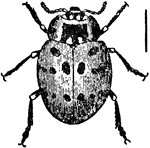
Ladybug
Coccinellidae is a family of beetles, known variously as ladybirds (British English, Australian English,…
Rail Fork
"A track-layers' bar having two parallel blunt arms at the end the space between which is designed to…
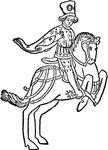
Squire
In feudal or medieval times a squire was a man-at-arms in the service of a knight, often as his apprentice.…
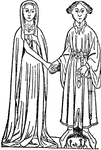
Squire and Wife
An illustration of a squire and his wife. In feudal or medieval times a squire was a man-at-arms in…
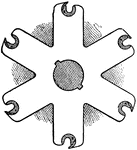
Rift Saw
"In wood-working, a saw in which the cutting-teeth are placed at the ends of radial arms instead of…

Knight and Captive
An illustration of a knight holding a prisoner with one hand and a sword with the other.
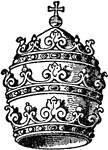
Papal Tiara
The Papal Tiara, also known as the Triple Tiara, or in Latin as the 'Triregnum', and in Italian as the…

Lion Coat of Arms
This Lion Coat of Arms is designed with inlayed marble work. It was found in St. Croce, Florence, Italy,…

Lion Coat of Arms
This Lion Coat of Arms is designed with an intarsia panel. It was found in St. Maria Novella, Florence,…

Grotesque Pilaster
The Grotesque pilaster is a squatting winged female without arms. It was designed during the Italian…
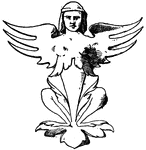
Winged Grotesque Pilaster
The Winged Grotesque pilaster is a squatting winged female without arms. It is found on the tomb of…
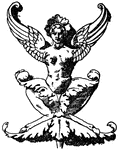
Flying Grotesque Pilaster
This Flying Grotesque pilaster is a squatting winged female without arms. It is found in a palace in…

Thin Grotesque Column
This Thin Grotesque column is a squatting winged female without arms. It is found in the Guadagni Palace…

Grotesque Column
This Grotesque column is a squatting winged female without arms. It is found in the Guadagni Palace…

Tassel Ribbon
This ribbon comes from Jost Amman's Wappen (coat of arms) during the German Renaissance.

Antique Candelabrum Base
The Antique candelabrum base is made out of bronze. It is divided into three legs that are stretched…
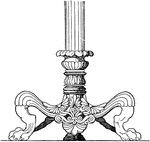
Antique Candelabrum Base
The Antique candelabrum base is made out of bronze. It is a design that is divided into three legs that…

Antique Candelabrum Base
The Antique candelabrum base is made out of bronze. It is a design that is divided into three legs that…
